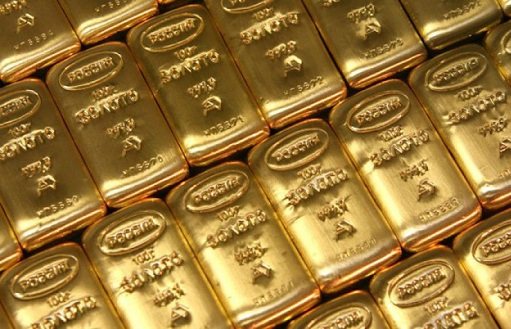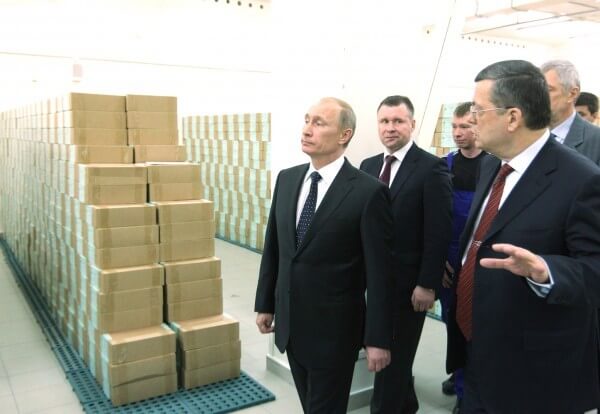In order to fully work, protect its interests and have funds for emergencies, each state creates financial reserves. From time immemorial, gold has been a means of preservation and accumulation.
And now no one is going to give up the gold reserves. Over the entire period of its existence, changes have been made to the structure of reserves, and the share of the gold metal itself has been reduced. The gold reserve began to be called the gold and foreign exchange reserve.
All securities, banknotes, gold bars do not actually lie in one place. Some are stored in different storage facilities, others work in different assets, increasing in volume. These reserves are the property of the state, and only it has the right to dispose of them as needed.
Gold is an international currency, equally valuable in all countries of the world. It maintains and secures the paper money in circulation. Gold reserves guarantee economic stability. Gold keeps money from inflation.
In addition to gold, the economy is now based on foreign currencies, mainly dollars. The state uses gold as a reserve source in case of urgent purchase of foreign currency or as collateral for a government loan.
Gold reserves
In Russia, the government mainly melts the gold it extracts from the ground and buys into coins and jewelry. This reserve is stored and to some extent also represents Russia's gold reserves. As a result, today the stock of gold represents gold and foreign exchange reserves, which are stored in the form of bars or coins. Gold and foreign exchange reserves are the main instrument that the Central Bank of Russia can manage.
Before the outbreak of World War I, approximately 40% of gold circulated freely in global financial circles. However, military actions significantly weakened the economies of many states. It was from this period that almost every state began to “nationalize” its existing gold reserves.
Gold reserves of the world's countries
Structure of gold and foreign exchange reserves.
Russia's gold and currency reserves consist of several types of reserves:
- Foreign currency (share about 80%). This includes cash currency, compulsory medical insurance, balances on correspondent accounts, deposits with a payment period of up to 1 year. The majority of foreign exchange reserves are occupied by the euro and the dollar. There is a small share of pounds, yen, francs, etc. Developing countries prefer currencies because they rise in value faster than gold. Developed countries prefer to give a large part to gold when forming gold and foreign currency reserves.
- Securities (share about 2%). These are debt securities issued by non-resident issuers with a rating class of at least “AA-” as assessed by leading rating agencies. The exception is securities received under reverse repurchase transactions. Conversion of securities to the dollar is carried out based on the exchange rate of the currency to the ruble.
- Reserve position in the IMF (share of about 1%). This is the currency component of a country's quota in the International Monetary Fund.
- Gold (share about 12%). This is gold in coins and bars, which is stored in the territory of the country and other states.
The formation of the Russian gold reserve
Almost until 1914 in Russia, the gold standard acted as the main financial instrument, that is, it acted as the main unit of calculation. At that time, the weight of one ruble was 0.774235 grams of gold. However, with the onset of 1917, the gold ruble ceased monetary circulation, and paper bills began to circulate instead. The gold is mostly stored from that time.
As of August 1914, Russia's gold and foreign exchange reserves were among the largest in the world and amounted to one billion 695 million rubles, which in weight terms provided 1311 tons of the yellow metal. However, during the war, some of the bullion was transported to England to pay for war loans, as well as for storage. As a result, with the end of the war, our country valued its gold fund at 594 million rubles less.
With the arrival of the Bolsheviks in 1917, the fund became even more depleted. In 1918, the bulk of the country's reserves, 505 tons, were captured by the White Guards. With the signing of a settlement agreement between Germany and the RSFSR, another 98 tons were exported from Russia. Subsequently, the gold fund was spent at a tremendous pace, which was explained by rapid industrialization and the acquisition of various equipment abroad. In 1928, Russia squandered its reserves, and the fund became depleted to 150 tons.
However, subsequently Russia began to accumulate its fund, and already in the year 1941 the gold and foreign exchange reserves grew to 2800 tons. Such a significant reserve made it possible to withstand the outbreak of the war and quickly recover after its end. By 1991, Russia had practically exhausted its reserves of the precious metal; it was estimated at 290 tons. In 2000, the new president of the Russian Federation received 384 tons.
System for storing government gold reserves in case of crisis
17.01.2018
What is the Russian Gold Reserve and what does the treasury actually look like? Why do all states prefer to store assets in case of a crisis in gold? How long does the average Russian need to work to stock the treasury like the state? And will gold prices rise in the near future? The answers to these and many other exciting questions are below.

Main gold vault
The Bank of Russia is a place where not everyone gets a chance to visit. The room, which contains several hundred tons of gold bullion, equivalent in value to a trillion rubles, evokes an unusual range of feelings. It is shocking to realize that the average Russian citizen would have to work for several million years to come close to owning such a sum. For obvious reasons, access to this treasury is very limited.
Every gold vault
appears differently. One pictures in his head a picture akin to Scrooge McDuck's storeroom, where you can dive and tumble in piles of coins. Another sees a dragon's cave or Aladdin's cave. However, the reality is not so beautiful: the bars are stored in lattice containers with seals, standing in multi-story rows along the walls. The true appearance of the country's main treasury is much less impressive than the format.
Each gold bar has a value of 30,000,000 rubles. Its weight is about 12 kilograms. Each sealed container contains 20 bars.
The work of warehouse employees is not easy. Literally every movement is regulated and for any occasion there are many instructions that must be remembered. Precious metal requires extremely careful handling; the ingots must remain in perfect condition. Even the table where they are weighed is covered with a special cloth to prevent the slightest scratch.
gold reserve workers
treat the tons of treasures surrounding them without reverence, calling them simply “metal.” For them it's just a daily job.
Currently, the reserves of the Central Bank contain precious metal exceeding 1,800 tons in volume. According to this parameter, Russia ranks sixth in the world ranking. A decade earlier, the share of Russian gold in international reserves was only 3%. But thanks to the efforts of the Central Bank to increase this asset, it grew to 17%.
For reference
Gold
- This is an emergency reserve in case of a crisis. If suddenly the state does not have enough foreign exchange reserves, the precious metal will be used. It can be either mortgaged or sold. Although historically gold has typically been more valuable, it is still highly valued in international markets.
Since the invention of money, gold has been the universal currency through which trade was carried out throughout the world. Then the volume of gold began to become a determining factor in the value of the national currency. This was carried out in the following way: a little gold was physically assigned to each banknote, and the volume of banknotes could be increased only by first increasing the stock of gold in the country. This avoided inflation. This state of affairs existed until 1944.
Then the value of gold fell, and the dollar took its place in mutual settlements; it is in this currency that most countries now prefer to keep their reserves. Moreover, developed countries can invest up to 60-70% of their assets in gold, although the actual volume of savings is less than in developing countries. Thus, gold is still of interest as a “box” in case of a crisis.
Dictionary
Monetary gold
- these are standard coins and bars created from pure gold, whose purity is not less than 995, which belong to the Central Bank and the government of the Russian Federation.
International reserves and gold and foreign exchange reserves are one and the same. These are storage facilities where the country's reserves are stored in the form of bullion, dollars or other financial instruments. These may include, for example, reserve positions in the IMF and special rights to loans, which are pseudo-currencies used as a universal means of payment. However, such tools are not in widespread demand.
Theoretically, the structure of reserves should be based on the structure of export and import operations in the country.
Historical excursion
In 1914, the gold reserves of the Russian Empire totaled 1,312 tons of the precious metal. At that time, this volume allowed the country to be one of the three world leaders in terms of reserve volumes, along with France and the United States.
A decade after the revolutions, civil war and World War I, the Soviet Union's reserves were practically zero to 150 tons. However, during the reign of I.V. Stalin’s “liquid” began to rapidly replenish and reached its historical maximum in 1941 - 2800 tons.
And under the new government in 1991, only the remnants of its former greatness remained - 290 tons of precious metal.
Who holds the world's gold in their hands?

How much gold is there on the planet? It is very difficult to answer this question. Its estimated volume is 190,000 tons, most of which is owned by private individuals and stored in the form of jewelry. 33.5 thousand tons are the national reserves of states. The remainder is used by funds and market giants as investment assets, a small part of it serves “technical” needs - it is used in various industrial fields and in dentistry.
Each bar o (“refined gold”) is a trademark of the manufacturer, thanks to which you can easily find out where and when this bar was made, as well as the sample of the metal in it and its weight.
The fineness of bars can vary from 99.95 to 99.995. These numbers coincide with the percentage of pure gold in the product. The remaining tenths and hundredths of a percent are occupied by other metals, both precious and non-precious. Each ingot is supplied with a unique quality certificate.
The cost of gold on the world market
constantly changes depending on stock quotes. Thus, the price of an ingot of 30,000,000 rubles is approximate.
Will gold prices rise?
People generally believe that gold can only rise in price. Even a number of analysts agree with this opinion and continue to repeat these words like a mantra, not paying attention to real indicators. In reality, the value of the precious metal can fluctuate. Although, sometimes the duration of fluctuations takes tens of years. However, it is impossible to predict gold prices with complete confidence. Even if you interview ten specialists, their opinions will vary to completely opposite ones, and most likely will not guess correctly.
The years 2011-2012 were very indicative in this regard, when the cost of a troy ounce (31.13 grams) suddenly jumped to $1,900. There were huge wars among analysts predicting further growth. The winner of these competitions was the executive director of Euro Pacific Capital, Peter Schiff, who claimed that the price would rise to $5,000 and that this would not be the limit. He passionately advocated for all investors to buy the precious metal, promising them fantastic profits. However, everything turned out exactly the opposite, and those who listened to Schiff’s advice ended up losing.
Another financial adviser gloomily said that gold should only be purchased if you are an adherent of the theory of an imminent apocalypse. In the event of a nuclear disaster, you can buy bread with your gold. Also, gold, in his opinion, can be purchased for beauty.
Does it make sense to invest in gold?
and how to do it correctly? This is a controversial issue. There are many ways to invest in gold, and they all have their drawbacks. Whether the moral and financial costs are worth the expected profit, everyone needs to decide for themselves.
to the list
What influences the growth of gold reserves?
- The increase in reserves is mainly due to significant mining of this metal in Russia;
- International loans;
- Export of export goods abroad.
In addition, the volume of reserves is influenced by the number of scrap gold handed over to the population and the activities of banks that sell off their reserves.
Most states are using new opportunities to obtain metal to increase their reserves:
- processing of low-grade ores;
- reactivation of abandoned mines;
- the use of new technologies and the like.
Modern stocks
Today, purchasing gold is a very profitable process, because the cost of the precious metal has increased by 400% in recent years. By 2013, Russia had increased its reserves by 10% since 2007. From 2002 to 2012, the increase was approximately 570 tons.
According to official data, the country's reserves as of 2014 contain 1,041 tons. Thanks to such indicators, Russia can reach 6th place in the world, because several advanced countries do not stand out for the rapid increase in precious metals. In 2015, the Central Bank began purchasing almost all of the yellow metal mined in our country. This was caused by sanctions, as well as the desire to increase the volume of reserves.
Russia's place in the world ranking of gold reserves
According to statistics, over the past few years Russia has purchased more precious metal than all the EU countries together with the United States. This allowed us to improve the indicator and rise to the top of the ranking in terms of gold reserves. To date, places in the TOP are distributed as follows:
- United States of America - the country's gold reserves are 8133.5 tons;
- Germany – number of ingots in reserve – 3371 tons;
- Italy - gold reserves are 2451.8 tons;
- France – the country has 2,436 tons of bullion in its reserves;
- Russian Federation – gold reserves are 2036.3 tons.
China, Japan, and Switzerland close the ranking of countries.
Why are reserves needed?

A century ago, gold was a universal currency, but over time, countries switched to banknotes, and the metal itself had to serve as a reserve. It was supposed to serve as a guarantee for international payments, as well as be a safety net.
Today, world gold reserves have decreased, and countries rely mostly on the dollar. In our country, gold reserves are located and stored in the form of a reserve fund, which should help in difficult times or for the purchase of goods abroad.
Why was gold chosen to form the fund?
Gold is a precious metal that is valued in all countries of the world. This distinguishes it from a national currency, which is valuable only for the country where it is in demand. It is for this reason that gold was chosen as the world's medium of exchange.
Previously, coins were minted from this precious metal. They were used to pay for goods all over the world. When banknotes were created, a gold fund was formed, the main task of which was to ensure the value of paper funds. Today, the precious metal reserve is also an anti-crisis measure.
Where are our stocks located?
At the moment, our country stores its reserves in the Central Vault of the Central Bank, which is located in Moscow. The storage area totals more than 17 thousand m². Gold is stored mainly in bars that weigh 10-14 kg, as well as in measured bars of 0.1-1 kg. The Central Vault houses approximately 6,100 boxes containing precious metal. In addition, there is also a decent supply of banknotes in case of an unforeseen situation.
The yellow metal is stored securely and protected from any external threats. The premises have the latest security systems, which allows you not to worry about the safety of its contents. This is probably why the government of our country makes no secrets about the location of our greatest wealth.











